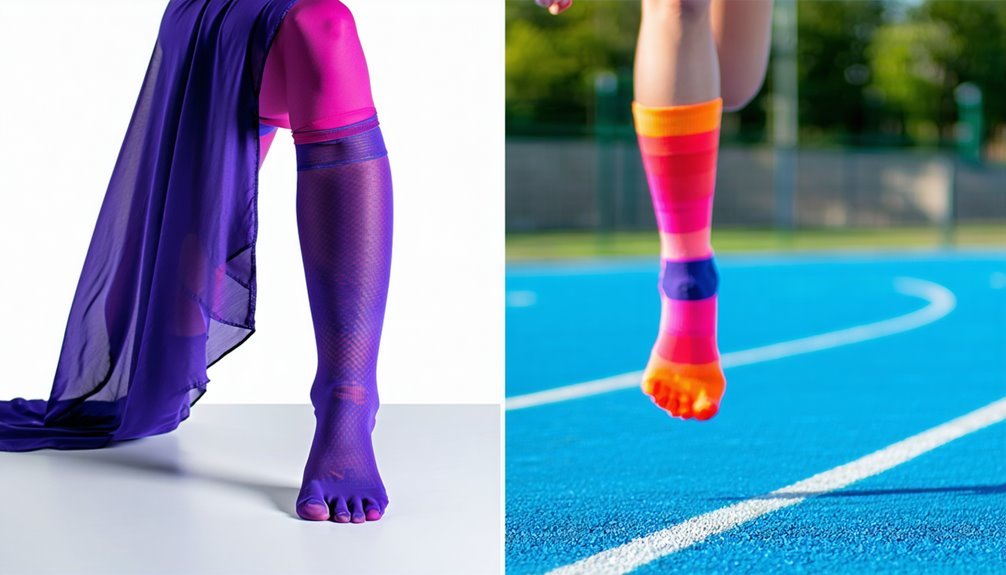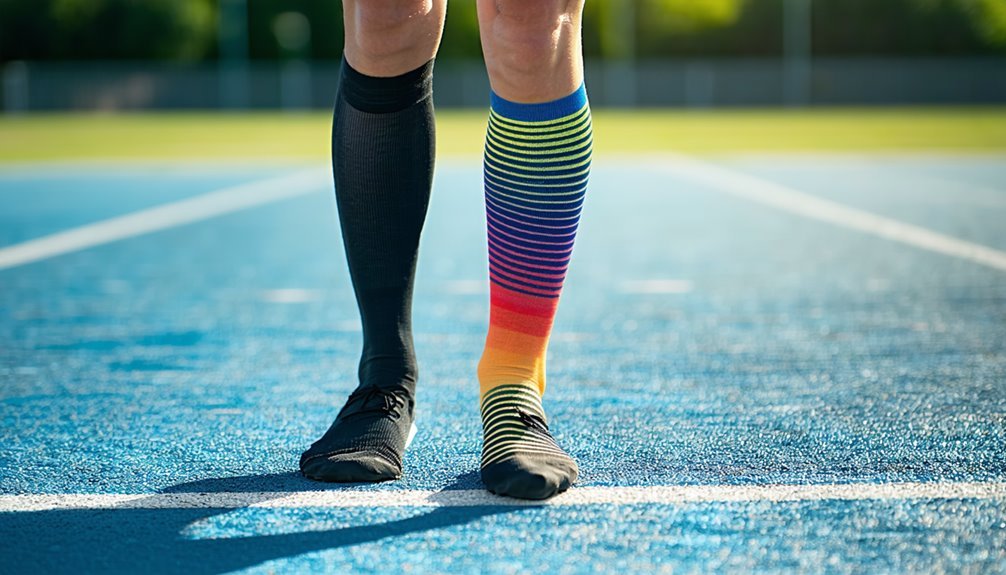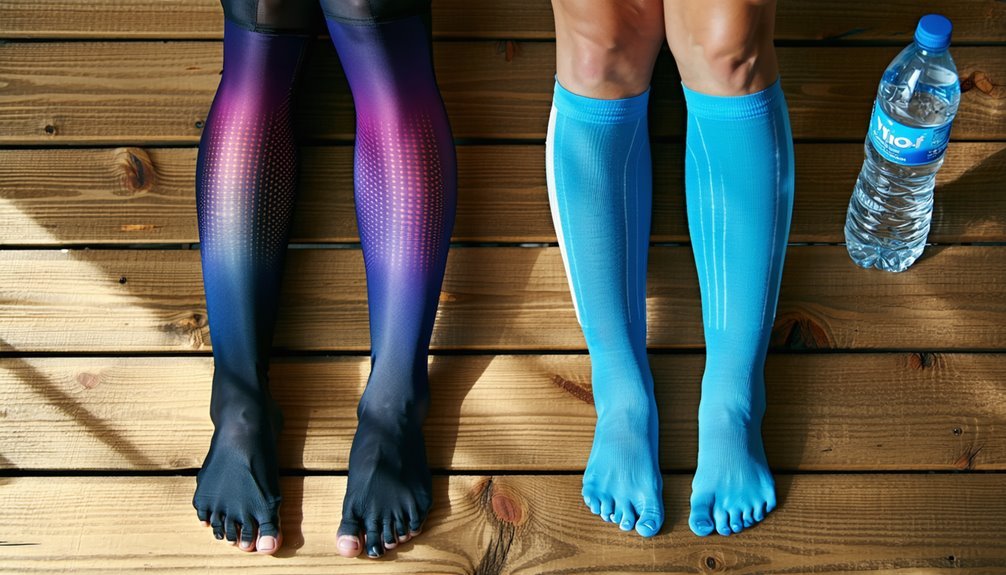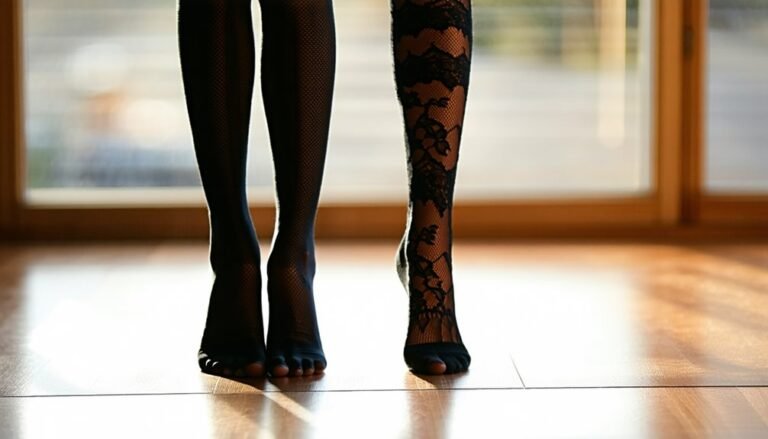Compression Sleeve Vs Socks
When choosing between compression sleeves and socks, each has its benefits. Compression sleeves target specific areas like arms or legs, enhancing circulation and muscle support without foot restriction. Socks provide extensive leg coverage, decreasing DVT risk and boosting venous return. Both options come with various compression levels, so consulting a healthcare provider is essential for tailored advice. By exploring further, you'll reveal insights into selecting and maximizing the benefits of compression gear for your needs.
Understanding the Basics of Compression Gear

When it comes to understanding the basics of compression gear, it is vital to know that these specialized garments, including sleeves and socks, are designed to apply gentle pressure to your limbs. This pressure aids in improving circulation and reducing swelling. You'll find different compression types, each tailored to specific needs, such as mild, moderate, or firm compression. It is important to choose the right type based on your medical requirements or activity level.
The material differences in compression gear also play a significant role in their effectiveness and comfort. High-quality materials like nylon, spandex, and elastane guarantee durability and flexibility, providing a snug yet comfortable fit. Selecting the appropriate material for your compression gear will guarantee peak support while prioritizing your safety and comfort.
Key Benefits of Compression Sleeves
Though often overlooked, compression sleeves offer a multitude of benefits that can greatly enhance your physical well-being. They provide consistent pressure, which improves blood circulation and reduces swelling in your arms or legs. This enhanced circulation is essential for preventing injuries and accelerating muscle recovery post-exercise. The compression benefits also extend to reducing muscle soreness and fatigue, allowing you to maintain activity levels safely.
Moreover, sleeve comfort is a key aspect, ensuring a snug fit without restricting movement. The material's breathability helps regulate temperature, minimizing the risk of overheating during physical activities. By promoting proper blood flow and offering gentle support, compression sleeves can be an invaluable addition to your fitness routine, contributing to overall safety and well-being.
Advantages of Wearing Compression Socks
While compression sleeves are beneficial for the arms and legs, compression socks specifically cater to the needs of your lower extremities. These socks provide several health benefits and can enhance your athletic performance. By improving circulation, they help prevent swelling and reduce the risk of deep vein thrombosis (DVT), ensuring your safety during prolonged periods of inactivity or physical exertion. Here's why you might consider them:
- Improved Blood Flow: Compression socks can enhance venous return, which is essential for maintaining healthy circulation and minimizing leg fatigue.
- Reduced Muscle Soreness: By diminishing muscle oscillation, they aid in faster recovery post-exercise.
- Enhanced Stability: They offer support to your calves and ankles, reducing the likelihood of injuries during athletic activities.
Choosing compression socks can be a proactive step toward safeguarding your health.
Comparing Compression Levels: Sleeves Vs Socks
Understanding the differences in compression levels between sleeves and socks is vital for making an informed choice tailored to your specific needs. Compression sleeves offer greater flexibility, allowing you to target specific areas, such as calves, while maintaining a full range of motion. This can be particularly beneficial if you require focused support without restricting foot movement. In contrast, compression socks provide broader coverage, encompassing both the foot and calf. This guarantees even pressure distribution, which may enhance circulation more thoroughly for individuals needing full leg support.
When evaluating safety, consider your medical history and consult a healthcare provider to guarantee maximum benefits. Both sleeves and socks come in various compression levels, so selecting the appropriate one is important to avoid adverse effects while promoting effective recovery and comfort.
Choosing the Right Compression for Your Activity

When deciding on the right compression for your activity, how should you determine which option best suits your needs? Consider the following factors to guarantee a safe and effective choice:
- Activity Type: For running or high-intensity workouts, a snug sleeve fit may provide better muscle support. For prolonged standing or travel, opt for socks with a supportive sock fabric to promote comfort.
- Personal Comfort: Evaluate how each option feels. A proper sleeve fit should be firm yet comfortable, while sock fabric should be breathable and moisture-wicking.
- Compression Needs: Assess the level of compression required for your activity. Higher levels are often necessary for intense activities, while moderate levels suit daily wear.
Using these guidelines, you can select the right compression option with confidence.
Impact on Circulation and Blood Flow
Compression garments play a critical role in enhancing circulation and blood flow, especially during physical activities or prolonged periods of inactivity. When you wear compression sleeves or socks, they apply gentle pressure to your limbs, promoting circulation improvement by assisting the veins in moving blood back to your heart. This blood flow enhancement can greatly reduce the risk of blood clots, swelling, and muscle fatigue, offering you peace of mind and additional safety.
Both compression sleeves and socks are designed to provide targeted support. Sleeves are ideal if you're focusing on the calves, while socks cover the entire foot and lower leg, offering thorough coverage. Choosing the right type guarantees you receive the best benefits, enhancing your overall vascular health and well-being.
Enhancing Recovery With Compression Gear
Although often overlooked, post-exercise recovery is a vital aspect of maintaining ideal physical health, and compression gear can greatly enhance this process. By incorporating recovery techniques like wearing compression sleeves or socks, you can aid muscle regeneration and reduce soreness. Here's how compression gear can help:
- Increased Blood Flow: Compression gear supports venous return, enhancing nutrient delivery and waste removal, essential for muscle regeneration.
- Reduced Muscle Soreness: By minimizing muscle oscillation during and after exercise, compression garments may decrease the risk of delayed onset muscle soreness (DOMS).
- Enhanced Recovery Time: Consistent use of compression gear can shorten recovery periods, allowing you to safely resume physical activities sooner.
These benefits make compression gear a safe, evidence-based option for enhancing your recovery process.
Factors to Consider When Selecting Compression Wear
Choosing the right compression wear is vital for maximizing its benefits and guaranteeing comfort during use. When selecting, focus on the compression level and material type. These factors play a significant role in both safety and effectiveness. Higher compression levels are ideal for reducing swelling, while moderate levels may be more suitable for daily wear. Material type influences breathability and moisture-wicking, important for preventing skin irritation. Here's a quick comparison to guide your choice:
| Compression Level | Material Type | Benefits |
|---|---|---|
| High | Synthetic | Swelling reduction |
| Moderate | Cotton blend | Daily comfort |
| Low | Nylon | Light support |
Prioritizing these factors guarantees your compression wear offers superior support and safety, tailored to your needs.
Compression Gear for Different Sports and Activities

When selecting compression gear for sports and activities, it's essential to take into account the specific demands of the activity and how compression can enhance performance and recovery. Evidence suggests that different sports benefit uniquely from targeted compression. For basketball, sleeves can provide joint stability and enhance proprioception, potentially reducing injury risk. In contrast, running requires running socks that improve circulation and reduce muscle fatigue, aiding in endurance and recovery. Consider these factors:
- Basketball Sleeves: Enhance joint stability, potentially minimizing injury risk.
- Running Socks: Improve blood flow, reduce muscle fatigue, and aid endurance.
- Safety and Fit: guarantee proper sizing for effective compression without restricting movement.
Prioritizing sport-specific compression gear can support performance while maintaining safety.
Expert Tips for Maximizing the Benefits of Compression Gear
Understanding how to maximize the benefits of compression gear can greatly enhance your performance and recovery. First, verify your compression fit is snug but not restrictive. It should support muscles without impeding circulation. Prioritize fabric technology that is moisture-wicking and breathable, as these features maintain skin health by reducing irritation and overheating. Additionally, consider wearing compression gear during and after physical activity. This practice aids in reducing muscle soreness and improving circulation, supporting faster recovery. Always follow manufacturer guidelines to maintain the integrity of the fabric technology. Finally, consult with a healthcare professional to tailor your compression needs, especially if you have underlying health conditions. By adhering to these tips, you can safely optimize the effectiveness of your compression gear.
Frequently Asked Questions
Can Compression Sleeves or Socks Help With Weight Loss?
While compression gear might seem like magic from a fairy tale, it doesn't directly boost caloric burn or metabolic rate for weight loss. However, it can enhance circulation, supporting your exercise recovery and overall safety during physical activities.
Are There Any Fashion-Forward Designs Available for Compression Gear?
You're in luck! Compression gear now includes trendy patterns and stylish colors. While maintaining clinical efficacy, these options guarantee safety and comfort, allowing you to enjoy therapeutic benefits without compromising on style. Choose wisely for ideal results.
How Do Compression Garments Affect Skin Health?
Compression garments can enhance skin hydration and circulation improvement. You'll likely experience better skin health as increased blood flow supports nutrient delivery, while maintaining moisture levels helps prevent dryness and irritation, ensuring your skin stays safe and healthy.
What Is the Environmental Impact of Producing Compression Gear?
You're concerned about the environmental impact of producing compression gear. Opt for products using sustainable materials and eco-friendly manufacturing processes. These choices can reduce harmful emissions and resource depletion, ensuring safety for both you and the planet.
Are Compression Sleeves or Socks Suitable for Pregnant Women?
For pregnant women, compression wear enhances circulation, providing pregnancy benefits like reduced swelling and discomfort. You'll find either sleeves or socks suitable, but consult your healthcare provider to guarantee safety and ideal fit for your needs.







